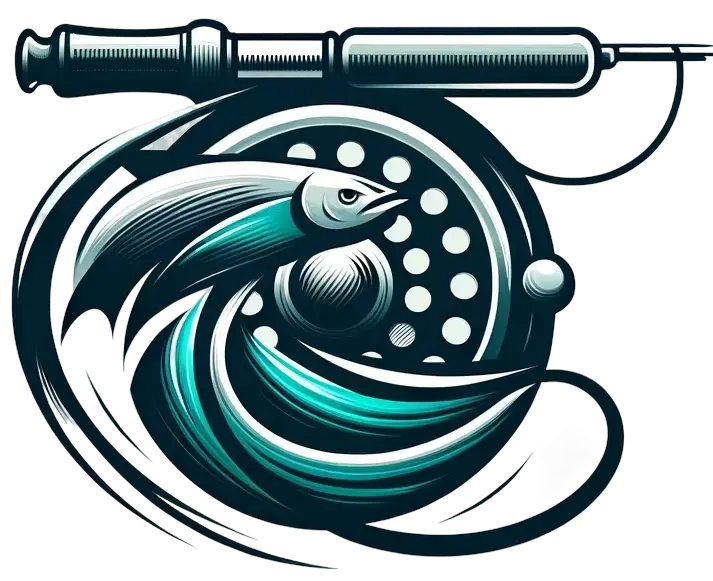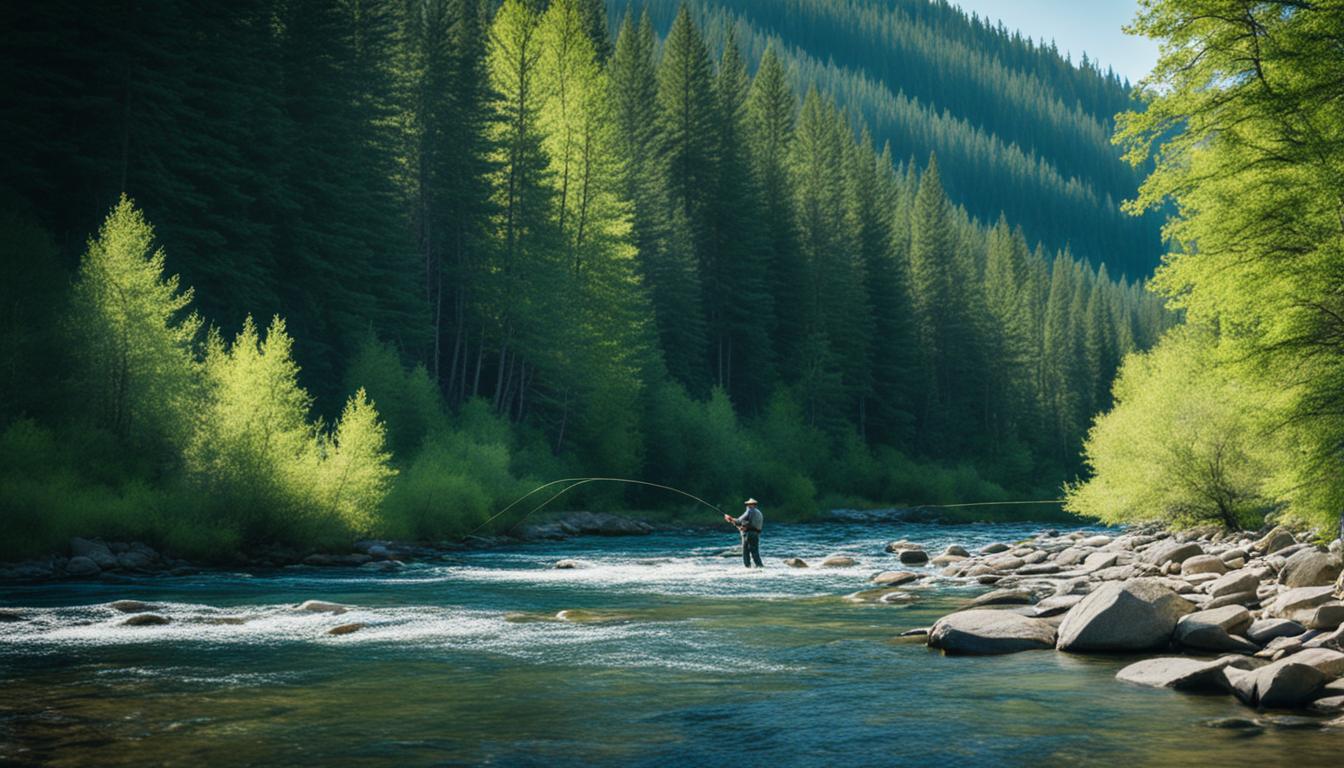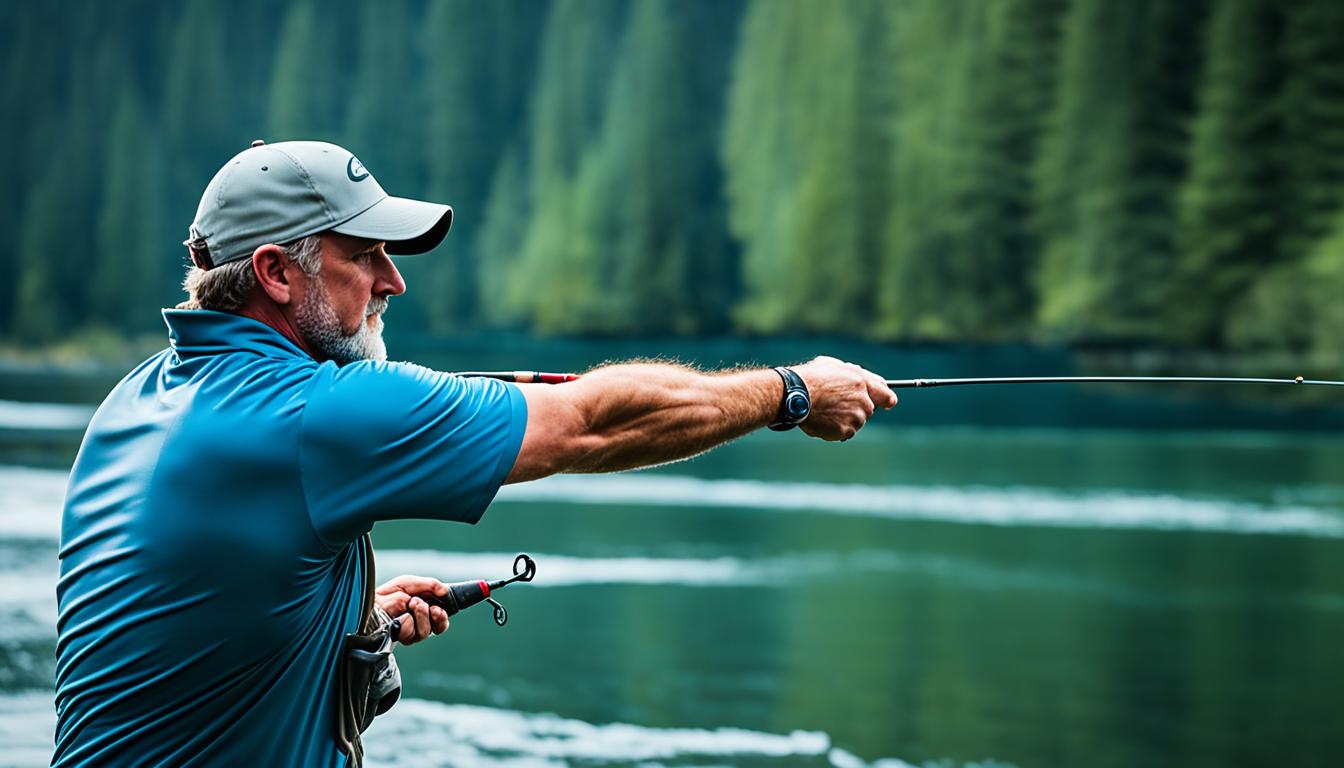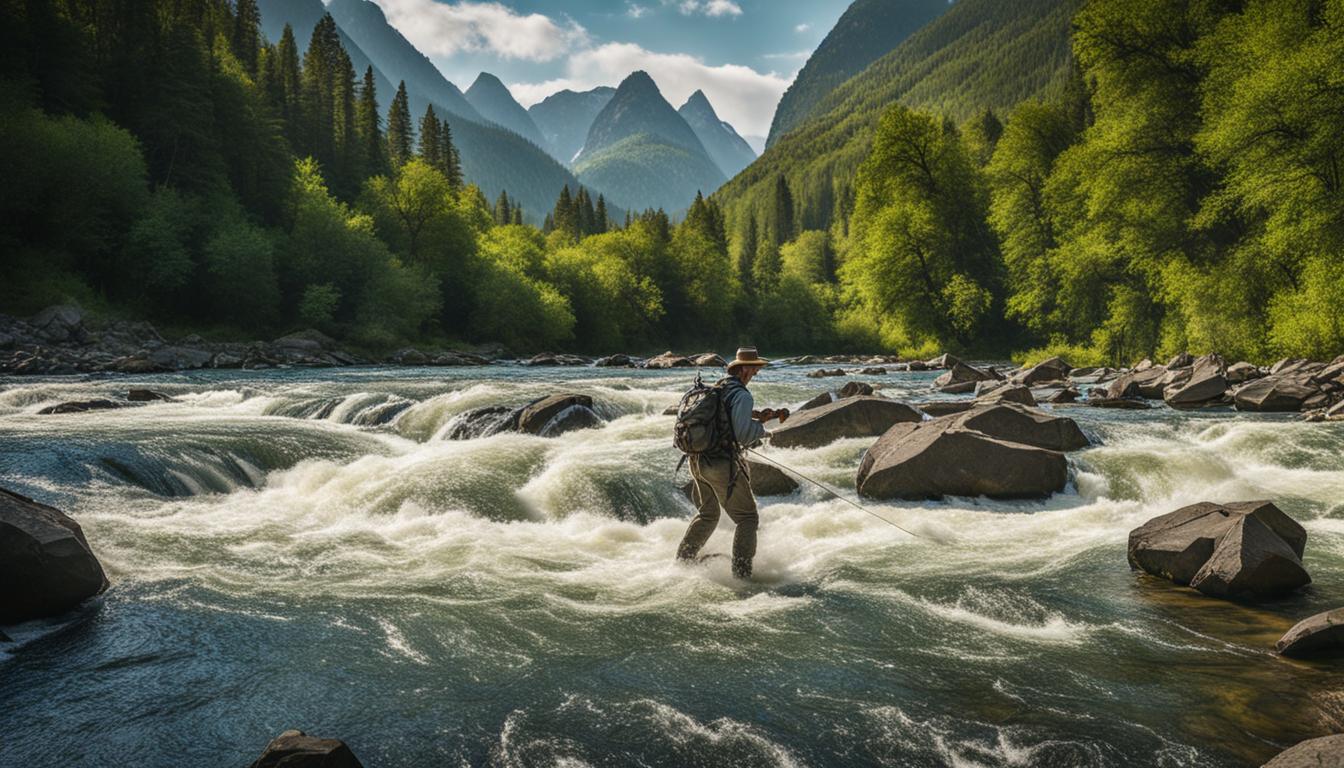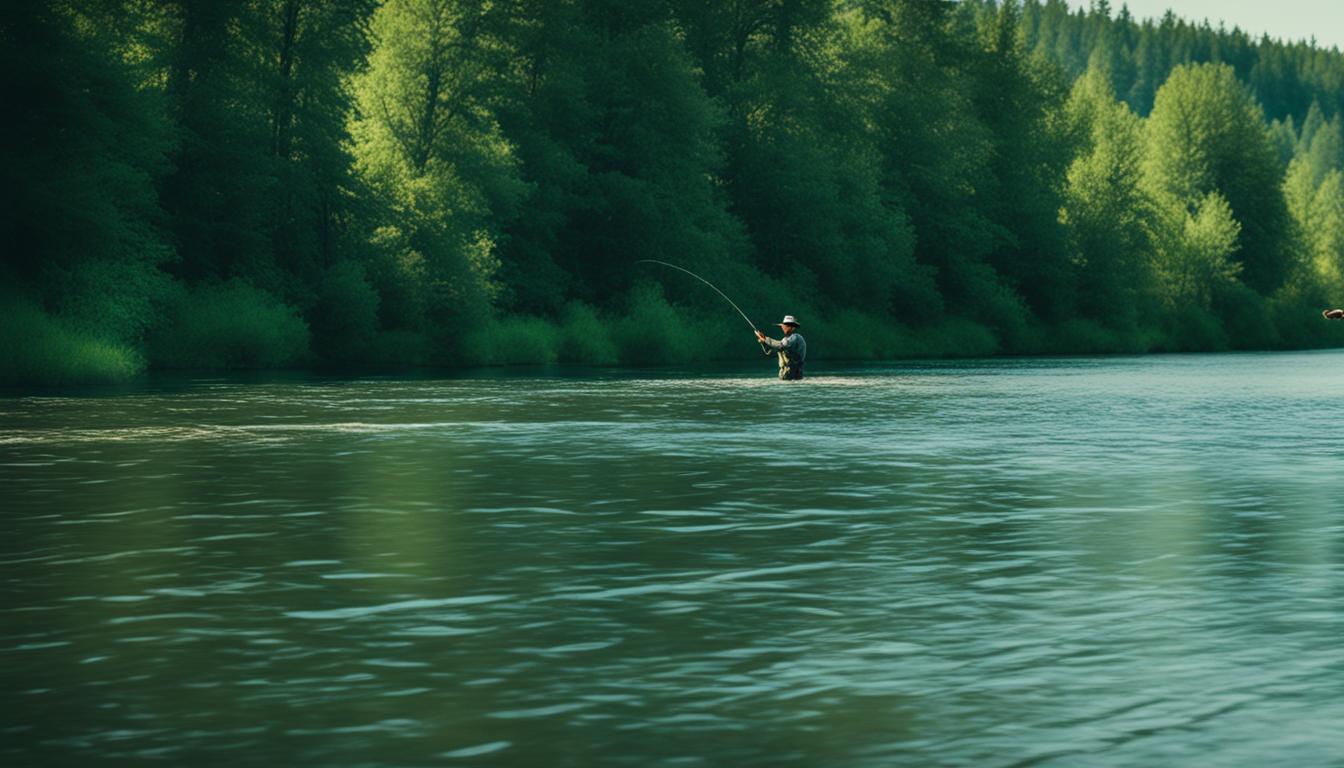Fly fishing in small streams can be an exhilarating and rewarding experience for anglers. The intimate waterways present their own unique set of challenges and opportunities, requiring specialized techniques and gear. By understanding the dynamics of small streams and employing the right strategies, you can enhance your chances of success and create unforgettable angling adventures.
Whether you’re a seasoned angler looking to expand your fly fishing repertoire or a beginner eager to explore the mesmerizing world of small streams, this article will provide you with valuable insights and tips to help you master the art of fly fishing in small streams.
Key Takeaways:
- Choose a shorter and lighter fly rod for navigating the tight spaces and dense vegetation in small streams.
- Fish upstream rather than downstream to increase your chances of catching fish without disturbing the water.
- Utilize shorter leaders to enhance maneuverability and accuracy when casting in small streams.
- Master the roll cast technique to effectively cast without the need for a backcast in tight spaces.
- Have a variety of fly patterns in different sizes and colors to match the available food sources in small streams.
Choosing the Proper Fly Rod for Small Streams
When fishing in small streams, selecting the right fly rod is crucial. A shorter and lighter rod is ideal for navigating the tight spaces and dense vegetation often found in small streams. A 6-7 foot long, 2-4 weight rod is recommended for accurate and effective casting in small stream environments. Using a stiffer and heavier rod can make it difficult to load line for short and precise casts required in small streams.
With a shorter and lighter rod, anglers can easily maneuver through narrow passages and cast with precision in small streams. The lighter weight allows for better control and accuracy, making it easier to present the fly in tight spots. Additionally, the shorter length provides better casting control in confined spaces, helping to avoid tangling the line in vegetation or obstacles.
The proper fly rod not only enhances your casting capabilities but also ensures a delicate presentation of the fly. This is crucial in small streams where trout can be wary and easily spooked. The lighter action of a small stream fly rod allows for a more subtle approach, increasing your chances of a successful catch.
Choosing the right fly rod for small streams is like finding the perfect tool for a specific job. It enables us to navigate the challenges of these intimate waterways and enjoy the exhilarating experience of landing trout in their hidden habitats.
Investing in a quality small stream fly rod will greatly enhance your fishing experience. Look for a rod that offers a balanced blend of sensitivity and strength, allowing you to feel every subtle take while providing enough backbone to handle smaller trout. Remember, the right fly rod is your key to unlocking the secrets of small stream fly fishing.
The Benefits of Choosing a Small Stream Fly Rod
| Benefits | Description |
|---|---|
| Maneuverability | A shorter rod allows for easier navigation through overgrown vegetation and tight spots. |
| Precision Casting | The lighter weight and shorter length provide better control and accuracy for precise casts in confined spaces. |
| Delicate Presentation | A small stream fly rod offers a more subtle approach, increasing the chances of fooling wary trout. |
| Enhanced Sensitivity | A quality small stream fly rod allows you to feel even the slightest takes, improving your hook-setting abilities. |
Fishing Upstream for Success in Small Streams
When it comes to fishing in small streams, our goal is to maximize our chances of success. One effective technique that can make a significant difference is fishing upstream. By approaching the fish from behind and upstream, we minimize the chances of being spotted and increase our chances of a successful catch.
Walking downstream and fishing can disturb the water, causing vibrations that can alert trout to our presence. Additionally, the disturbance can send debris and sediment downstream, further reducing visibility and making it difficult for fish to locate our flies. By fishing upstream, we avoid these issues and present a more natural and convincing presentation to the fish.
When fishing upstream, it’s essential to be mindful of our approach and casting technique. We want to avoid splashes and disturbances that could spook the fish. Soft, accurate casts are the key to success in small streams. By gently presenting our flies upstream, we mimic the natural drift of food sources and increase the likelihood of enticing a strike.
“Fishing upstream not only reduces the chances of spooking the fish but also allows for more effective control over the presentation of our flies.” – Expert Angler
By fishing upstream, we can take advantage of the natural behavior of fish in small streams. Trout in these tight waters often face upstream to search for food coming towards them. By approaching from behind, we use their natural feeding behavior to our advantage and position ourselves for an optimal presentation.
Remember, when fishing in small streams, be stealthy and patient. The confined space and clear water require a more delicate approach. By fishing upstream, we increase our chances of a successful catch by reducing the likelihood of alarm and presenting our flies in a more natural manner. So next time you find yourself on a small stream, give fishing upstream a try and see the difference it can make in your angling success.
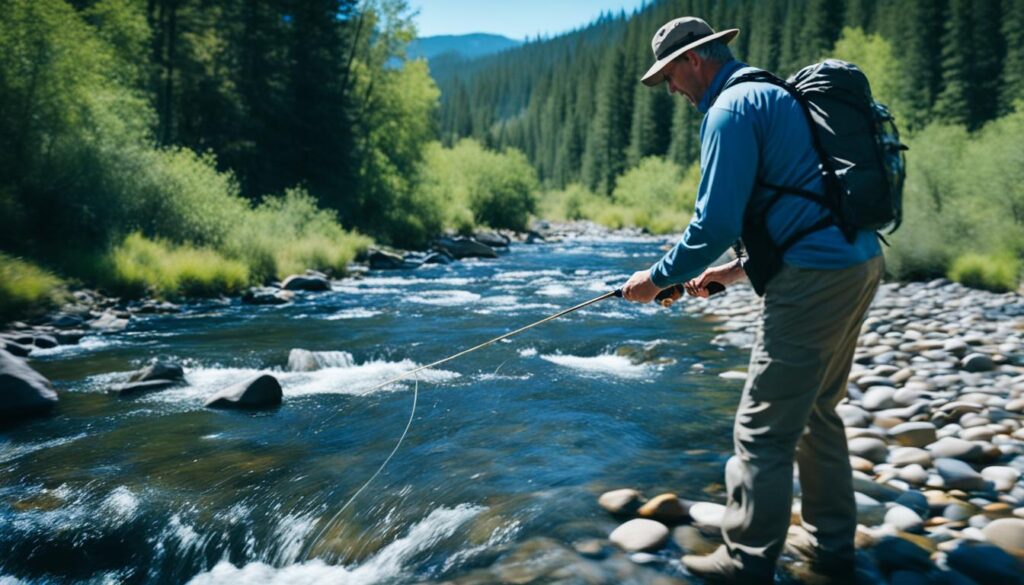
| Benefits of Fishing Upstream: | Techniques for Fishing Upstream: |
|---|---|
|
|
Utilizing Short Leaders for Small Stream Fishing
In small stream fishing, one of the key techniques to master is using shorter leaders. When navigating tight spaces and dense vegetation, longer leaders can easily get caught on obstacles during back casts, leading to decreased control and accuracy. To enhance maneuverability and precision, we recommend utilizing a 6-foot leader with 4-5x tippet for small stream fishing.
By shortening the leader, anglers can effectively navigate the challenges presented by small stream environments. Casting around obstacles becomes more manageable, allowing for better presentation of the fly and increasing the chances of enticing a strike from elusive trout. Additionally, the shorter leader enables quick and accurate line control, essential for making delicate presentations in tight spaces.
Advantages of Short Leaders in Small Stream Fishing
- Improved maneuverability: Shorter leaders provide greater control and maneuverability, allowing anglers to cast with precision in restricted areas of small streams.
- Better accuracy: The reduced length of the leader minimizes the chances of getting tangled in vegetation, resulting in more accurate casts and presentations.
- Easier line control: With a shorter leader, anglers can quickly adjust the position and drift of the fly, increasing the chances of enticing strikes from trout.
In summary, utilizing shorter leaders is a valuable technique for successful small stream fishing. With improved maneuverability, better accuracy, and easier line control, anglers can effectively overcome the challenges that small streams present. Remember to tailor your leader length and tippet size based on the specific conditions of the stream and the trout’s behavior.
Mastering the Roll Cast in Small Streams
When it comes to fly fishing in small streams, mastering the roll cast is an essential skill. This casting technique allows anglers to effectively cast without the need for a backcast, which can be challenging in tight spaces. By learning and practicing the roll cast, you can significantly improve your casting accuracy and distance in small streams.
The roll cast is particularly useful when you have limited room for a traditional overhead cast. Instead of sweeping the rod backward, you simply lift and sweep the rod to the side, creating a loop of line behind you. As the loop unfurls, you can deliver your fly to the desired target with precision.
Why is the roll cast ideal for small streams?
The roll cast is ideal for small streams due to its versatility and efficiency. Here are a few reasons why it’s a valuable technique:
- Tight spaces: In small streams, tight vegetation and overhanging branches can limit your casting options. The roll cast allows you to present your fly accurately and delicately in confined spaces.
- No backcast needed: In many small streams, obstacles behind you make a backcast impossible. With the roll cast, you can avoid tangling your line and still make precise presentations.
- Minimal water disturbance: When fishing in small streams, stealth is crucial. The roll cast allows for a subtler delivery, minimizing water disturbance and increasing your chances of fooling wary trout.
By incorporating the roll cast into your small stream fly fishing repertoire, you’ll have greater control over your presentations and increase your chances of success.
| Advantages of the Roll Cast in Small Streams | Disadvantages of the Roll Cast in Small Streams |
|---|---|
| Allows for accurate and delicate presentations in tight spaces | Not suitable for long-distance casting |
| Avoids tangling line in obstacles behind you | Requires practice to achieve proper timing and loop formation |
| Minimizes water disturbance for stealthy approaches | May struggle with heavy flies or strong winds |
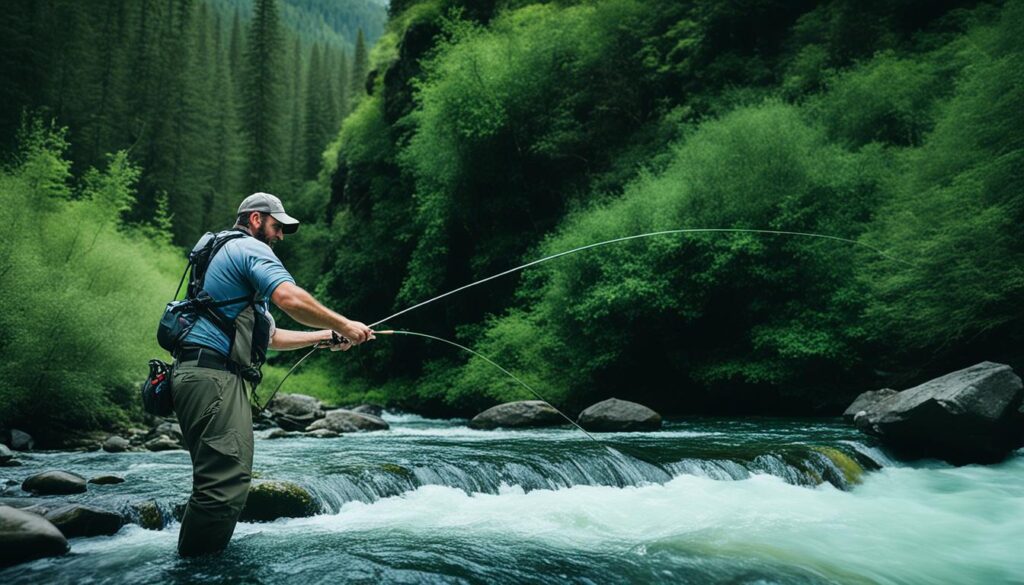
The roll cast is like a secret weapon in your small stream fishing arsenal. It’s the go-to technique for accurate and stealthy presentations in challenging environments. With practice, you’ll become a master of the roll cast, opening up new opportunities for success in small streams.
Fly Choices for Small Stream Fishing
When it comes to fly fishing in small streams, selecting the right flies is an important factor in enticing the trout to bite. The choice of flies can vary depending on factors such as the specific creek and prevailing hatch conditions. Understanding the behavior of the trout and their feeding patterns will greatly increase your chances of success.
In general, smaller stream trout are often more aggressive and will readily take larger flies. Unlike larger rivers, where matching the hatch is crucial, small streams have limited food sources, and trout will often feed on any available prey. This gives anglers the freedom to experiment with a variety of fly patterns and sizes. Having a diverse selection of flies in your tackle box will increase the chances of finding the perfect pattern that matches the trout’s preferences on any given day.
Here are some common fly patterns that have proven effective for small stream fishing:
- Elk Hair Caddis: This classic dry fly pattern imitates various small insects and is a great choice for surface feeding trout.
- Hopper: Mimicking grasshoppers and other terrestrial insects, the hopper pattern can entice aggressive strikes from hungry trout.
- Stimulator: Designed to imitate stoneflies and other large insects, the stimulator fly is visible and buoyant, making it an excellent attractor pattern.
- Woolly Bugger: An all-around versatile pattern, the woolly bugger imitates baitfish, leeches, and even large aquatic insects. It can be fished both on the surface and subsurface.
- Parachute Adams: This classic mayfly pattern is a reliable choice for small streams. It can imitate a variety of mayflies and is particularly effective in slower-moving pools.
Remember, small stream fishing is all about adaptability and matching the changing conditions of the stream. It’s important to experiment with different patterns, sizes, and colors to determine the trout’s preferences on any given day. Observing the natural insects present in the stream and using flies that closely resemble them will greatly increase your chances of success.
Tips for Choosing Flies in Small Streams:
- Carry a variety of fly patterns and sizes to cover a range of potential food sources.
- Observe the stream for natural insects and try to mimic their appearance and behavior with your fly selection.
- Experiment with different retrieval techniques to imitate the movement of prey.
- Pay attention to the trout’s feeding behavior and adjust your fly choice accordingly.
By being prepared with a well-stocked fly box and using the right fly patterns, you can maximize your chances of success in small stream fishing.
| Fly Pattern | Type | Imitates |
|---|---|---|
| Elk Hair Caddis | Dry fly | Various small insects |
| Hopper | Dry fly | Grasshoppers and terrestrial insects |
| Stimulator | Dry fly | Stoneflies and large insects |
| Woolly Bugger | Streamers | Baitfish, leeches, and large aquatic insects |
| Parachute Adams | Dry fly | Mayflies |
Understanding the Dynamics of Small Streams
When it comes to fly fishing techniques and small stream fishing tips, understanding the dynamics of small streams is essential for success. Small streams are unique environments with their own set of challenges and opportunities. By considering factors such as temperature fluctuations, turbidity, and wind, anglers can adapt their strategies and increase their chances of a fruitful fishing experience.
Temperature Fluctuations
One crucial aspect to grasp is the impact of temperature fluctuations on fish behavior in small streams. Different temperature conditions can affect the feeding patterns and activity levels of trout. To maximize your chances of success, it’s essential to know the optimal feeding temperatures for the specific species you are targeting. Time windows when water temperatures are ideal for feeding are the most productive periods to focus your efforts.
Turbidity and Water Clarity
Turbidity refers to the level of suspended particles in the water, which can affect water clarity. In small streams, turbidity can vary due to factors such as rain, runoff, and the presence of vegetation. Understanding how turbidity affects water clarity is key to making informed fishing decisions. Murky water may reduce visibility for both anglers and fish, making it more challenging to catch trout. However, some fish species may become more active in turbid conditions as it can provide cover and disorient prey.
Impact of Wind
Wind is another factor that can significantly influence fishing conditions in small streams. It can affect casting accuracy by causing line drag or disturbance on the water’s surface. Wind can also impact insect activity, as it may blow insects onto the water, increasing the chances of a hatch. By considering wind direction and speed, anglers can position themselves strategically and adjust their casting techniques accordingly.
Understanding the dynamics of small streams is crucial for small stream fishing success. By taking into account temperature fluctuations, turbidity, and wind, anglers can adapt their fishing strategies and increase their chances of catching trout. The more we know about these unique environments, the better prepared we are to make informed decisions and enjoy memorable fishing experiences.
| Key Factors | Impact |
|---|---|
| Temperature Fluctuations | Impact fish behavior and feeding patterns |
| Turbidity and Water Clarity | Affects visibility and fish activity |
| Wind | Influences casting accuracy and insect activity |
Conclusion
Fly fishing in small streams offers a unique and exhilarating angling experience for us fly anglers. It requires specialized techniques and equipment, but the rewards are well worth the effort. By choosing the appropriate fly rod, fishing upstream, using short leaders, mastering the roll cast, selecting the right flies, and understanding the dynamics of small streams, we can unlock the joys of fishing in these intimate waterways.
Patience, practice, and a sense of adventure are key in small stream fishing. With the right approach, even novice anglers can have memorable and rewarding angling experiences. Whether you’re catching trout or other species in small streams, these techniques and tips will help you make the most of your time on the water.
So, grab your fly rod, gear up with the best flies for small streams, and apply these small stream fishing tips to your next adventure. Explore the hidden gems of our local waterways, embrace the challenges they present, and relish the satisfaction of landing a beautiful fish in a picturesque setting. Get out there and discover the joys of fly fishing in small streams!
FAQ
What is small stream fishing?
Small stream fishing refers to the practice of fly fishing in narrow, intimate waterways such as creeks and brooks. These streams typically have limited space and can be challenging to navigate.
What is the best fly rod for small streams?
When fishing in small streams, it is recommended to use a shorter and lighter fly rod. A 6 to 7-foot long, 2 to 4-weight rod is ideal for accurate and effective casting in tight spaces.
Should I fish upstream or downstream in small streams?
It is best to fish upstream in small streams. By approaching the fish from behind and upstream, you are less likely to be spotted by the trout and increase your chances of success.
What length leader should I use for small stream fishing?
For small streams, a 6-foot leader with 4-5x tippet is recommended. Shorter leaders allow for better maneuverability and precision when casting around obstacles.
What is the roll cast and why is it important in small stream fishing?
The roll cast is a casting technique that allows anglers to effectively cast without the need for a backcast, which can be difficult in tight spaces. Mastering the roll cast is important for improving casting accuracy and distance in small streams.
What flies should I use for small stream fishing?
The choice of flies for small stream fishing can vary depending on the specific creek and prevailing hatch conditions. Smaller stream trout are often more aggressive and will readily take larger flies. It is essential to have a variety of fly patterns in different sizes and colors to cover a range of potential food sources.
What factors should I consider when fishing in small streams?
When fishing in small streams, it is important to consider factors such as temperature fluctuations, turbidity, and wind. Temperature fluctuations impact fish behavior, while turbidity affects water clarity and the presence of food sources. Wind can impact casting accuracy and insect activity.
Is small stream fishing suitable for all skill levels?
Yes, small stream fishing can be enjoyed by anglers of all skill levels. It offers a unique angling experience and with patience, practice, and a sense of adventure, it can provide memorable and rewarding fishing experiences.
